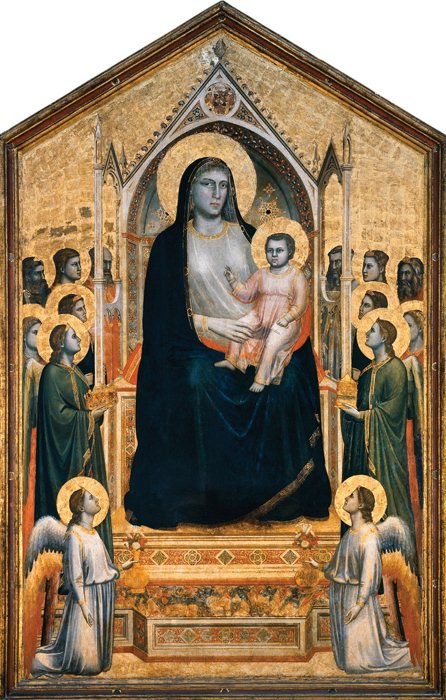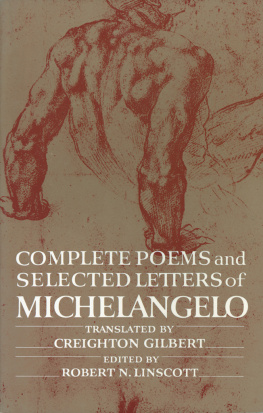Author: Eugene Mntz
Translator: Arthur Borges
Layout:
Baseline Co. Ltd,
61A-63A Vo Van Tan Street
4 th Floor
District 3, Ho Chi Minh City
Vietnam
ISBN: 978-1-78310-746-9
Confidential Concepts, worldwide, USA
Parkstone Press International, New York, USA
All media rights reserved worldwide
Unless otherwise mentioned, all reproductions are the copyright of the photographers. Despite due diligence, we have been unable to identify copyright holders in all cases. Anyone with a claim should contact the publisher.
Eugene Mntz
MICHELANGELO

CONTENTS

. PortraitofMichelangelo, ca. 1533. Black chalk. Teyler Museum, Haarlem.

CopyofafigurefromTributeMoneybyMasaccio, 1488-1495. Kupferstichkabinett, Munich.

. Raphael, LeonX, ca. 1517. Distemper on wood, 120 x 156 cm. Uffizi, Florence.
INTRODUCTION
The Brancacci Chapel and Uffizi Gallery in Florence amply illustrate the powerful influence on Michelangelo of his fellow masters. Cimabues MadonnaandChildEnthronedwithEightAngelsandFourProphets and Giottos OgnissantiMadonna, both at the Uffizi, plus Masaccios AdamandEveExpelledfromParadise at the Brancacci, all feed directly into one of the most talented and famous artists of Italys sixteenth century.
Up until the fourteenth century, artists ranked as lower-class manual labour. After long years of neglect, Florence began importing Greek painters to reinvigorate painting that had become stuck in a Byzantine style that was stiff, repetitious and top-heavy with gold.
Born in Arezzo, Margaritone was one little-known fourteenth-century painter who broke away from the Greek style that permeated painting and mosaics. Though a true pioneer, he is less remembered than Cimabue and Giotto. Also much influenced by Greek painting, Cimabue was a Florentine sculptor and painter who quickly injected brighter, more natural and vivacious colours into his paintings. We are still a long way from Michelangelos Sistine Chapel, but painting was now moving in its direction.
No later than the early fourteenth century, Giotto di Bondone had fully emancipated Florentine painting from the Byzantine tradition. This student of Cimabues redefined the painting of his era. Between Cimabues and Giottos works cited above, the new trend stands out in the rendering of the Virgins face and clothing. Cimabue was breaking out of the Byzantine mould. In a later work, he would himself come under the influence of one of his own students: Giottos HolyVirgin has a very lifelike gaze and cradles her infant in her arms like any normal caring young mother. The other figures in the composition appear less Byzantine and wear gold more sparingly. The pleating on her garb outlines the curves of her body. These features define his contribution to a fourteenth-century revolution in Florentine art. His skills as a portrait and landscape artist served him well when he later became chief architect of the Opera del Duomo in Florence, whose bell tower he started in the Florentine Gothic style. Like Michelangelo after him, he was a man of many talents. The fourteenth century proved most dynamic and Giottos style spread wide and far thanks to Bernardo Daddi, Taddeo Gaddi, Andrea di Cione (a.k.a. Orcagna) and other heirs.

. Cimabue, MadonnainMajestywithEightAngelsandFourProphets, ca. 1280. Distemper on wood, 385 x 223 cm. Uffizi, Florence.

. Giotto de Bondone, MadonnaEnthronedwithChild,AngelsandSaints, 1306-1310. Distemper on wood, 325 x 204 cm. Uffizi, Florence.

. Fra Angelico, Annunciation, 1430-32. San Marco, Florence.
Next came a period of International Gothic influence in the fifteenth century just as Masaccio erupted into the Florentine art scene with his rich intricacies of style. His impact on Michelangelo was to be dramatic. Masaccios actual name was Tommaso di Giovanni Cassi; born in 1401, he died after only twenty-seven hyperactive years. He was among the first to be called by his given name, a sure sign of new, higher social status for artists. Two noteworthy works are his Trinity at the Santa Maria Novella and the ExpulsionfromParadise in the Brancacci Chapel. This leading revolutionary of Italian Renaissance art upset all the existing rules. Influenced by Giotto, Brunelleschis new architectural attitude to perspective, Donatellos sculpture and other friends or cohorts, Masaccio added perspective into his frescoes alongside those of Brancacci, populated with figures so lifelike the eye almost senses their movements. Masaccio steers attention into exactly what to notice, leaving viewers no leeway for apathy. ExpulsionfromParadise is easily his masterpiece: hunched over with sin and guilt, the two figures radiate pure shame and suffering. It is distinctly more terrifying than Masolinos treatment of the same theme opposite it. Late twentieth-century restoration work on the chapel abolished the fig leaves, bringing all the genitalia back into full view: this was the first nude painting ever and Masaccio was offering art now far removed from anything Byzantine. His painting was so original that Fra Angelico, Leonardo da Vinci, Raphael, Caravaggio, Ingrs and Michelangelo himself all went out of their way to see it. Whatever direction their works took, each had his debt to Masaccio.
Masaccios legacy is huge. Fra Giovanni da Fiesole (a.k.a. Fra Angelico) came much under his influence, though many years his senior. This pious and humble Dominican friar completed lovely frescoes for the cloisters and cells of the San Marco Convent, including the Annunciation. Then came Domenico Veneziano, who ripened Fra Angelicos style into the full firm substance and refinement specific to Florentine Renaissance art.
In the mid-fifteenth century, humanist philosophy turned its back to the Middle Ages and reached out to Antiquity for inspiration. Meanwhile, art was looking to its Greco-Roman heritage as it too shunned all things medieval. Yet the term Renaissance was only invented in the nineteenth century when Jules Michelet published his
Next page


















